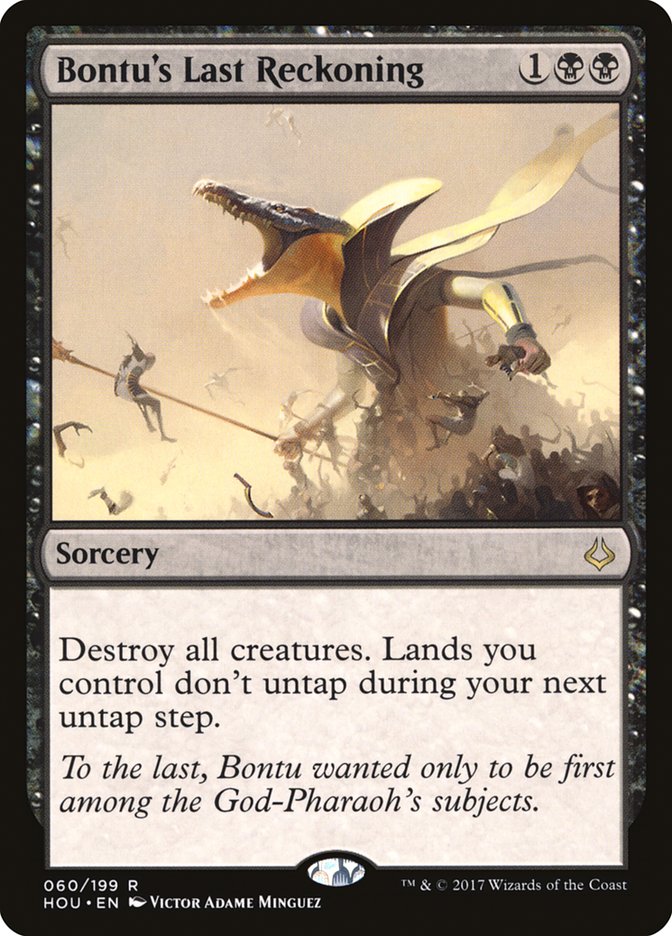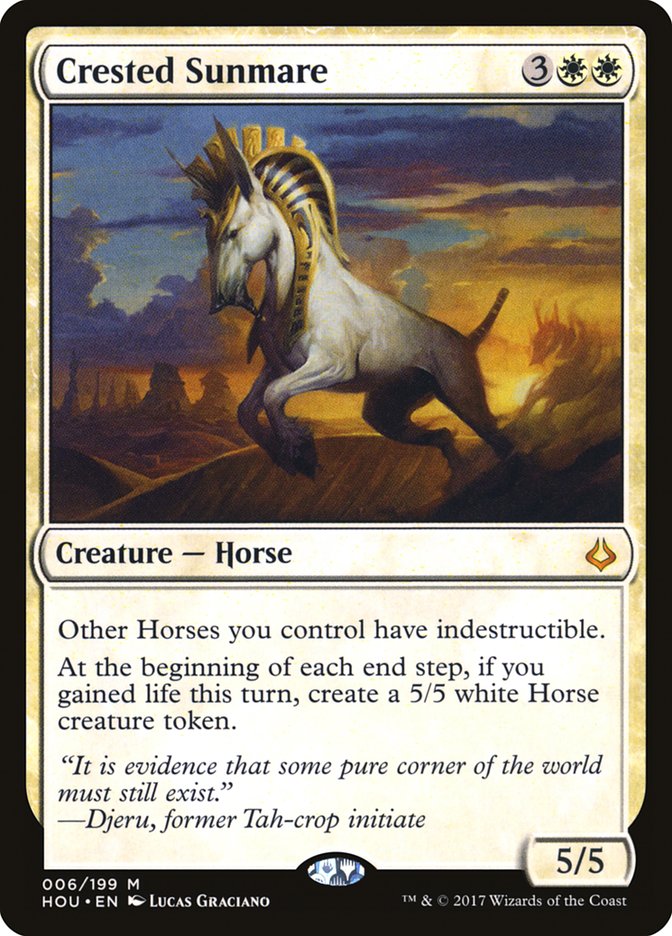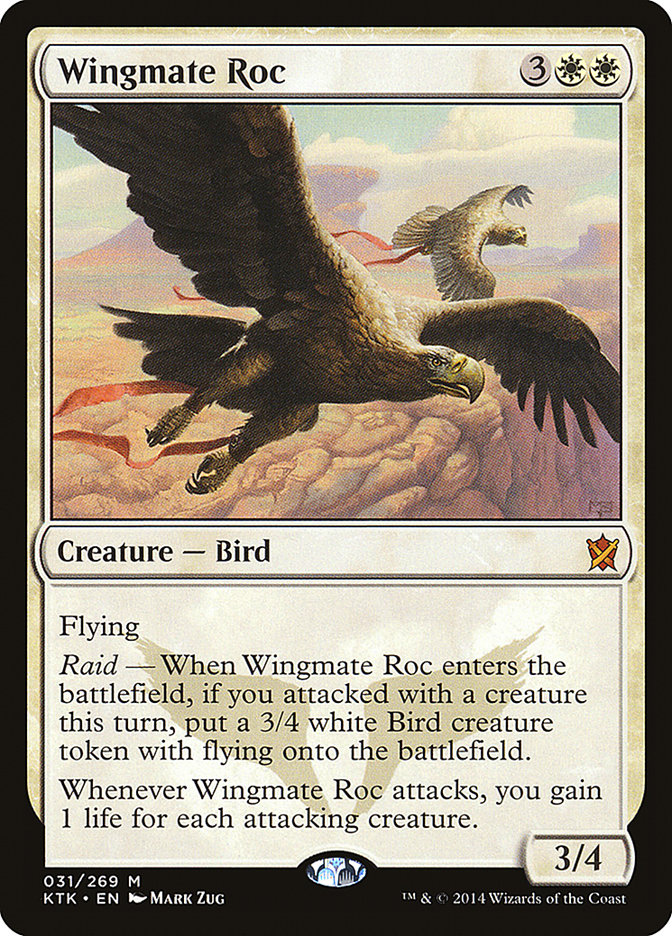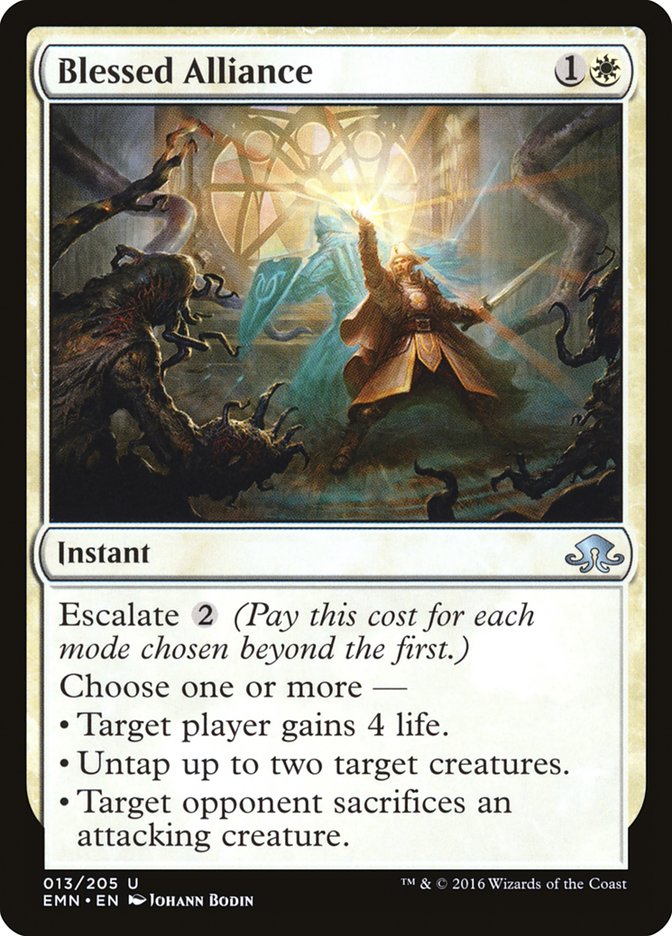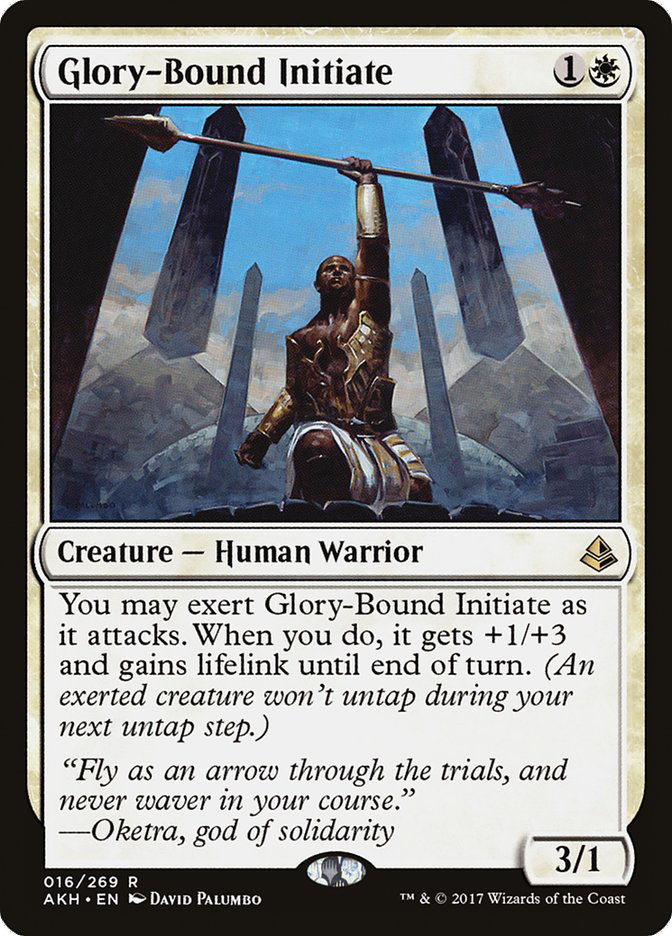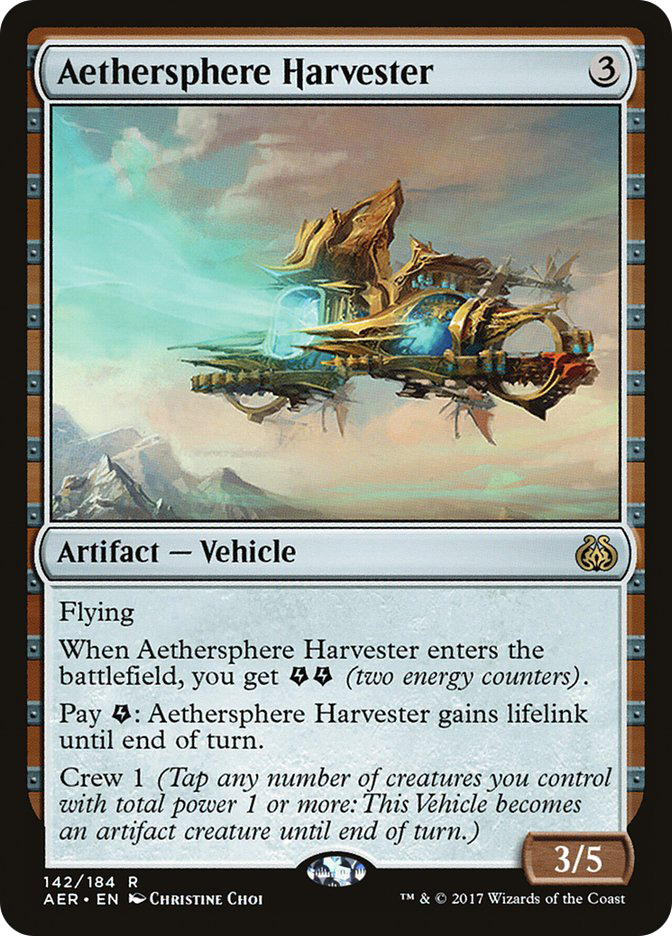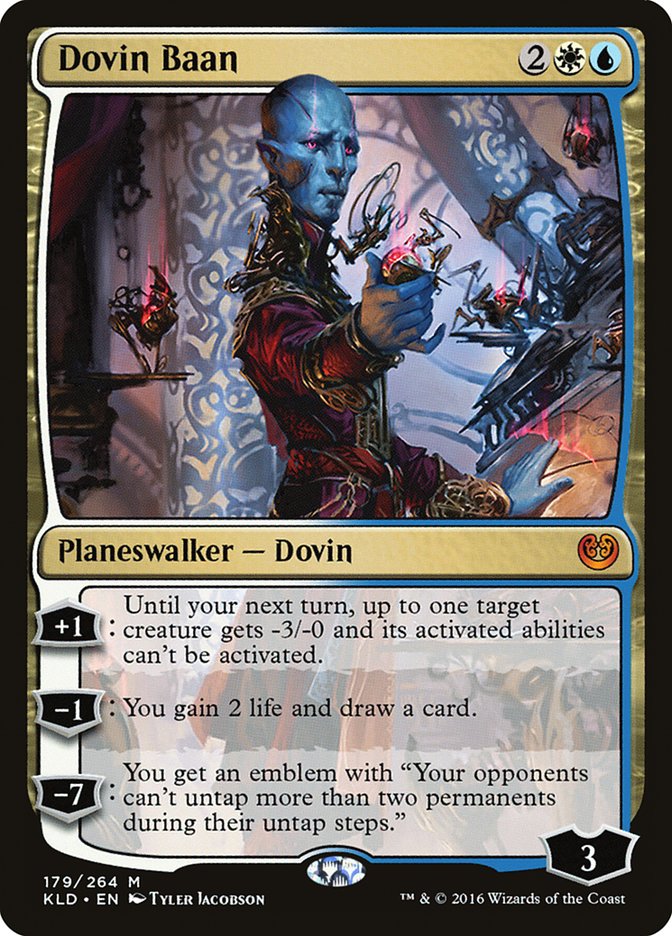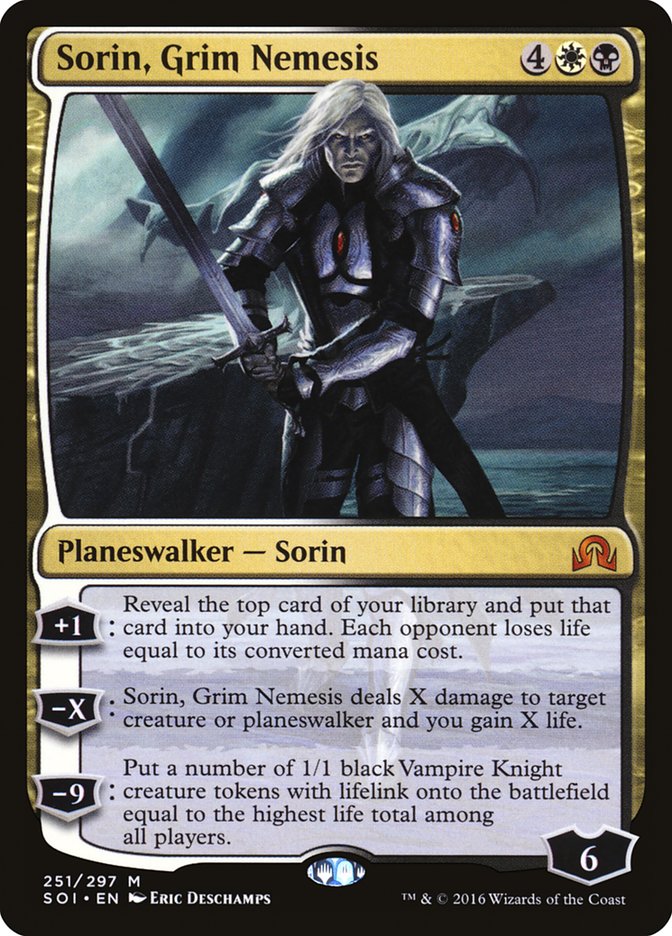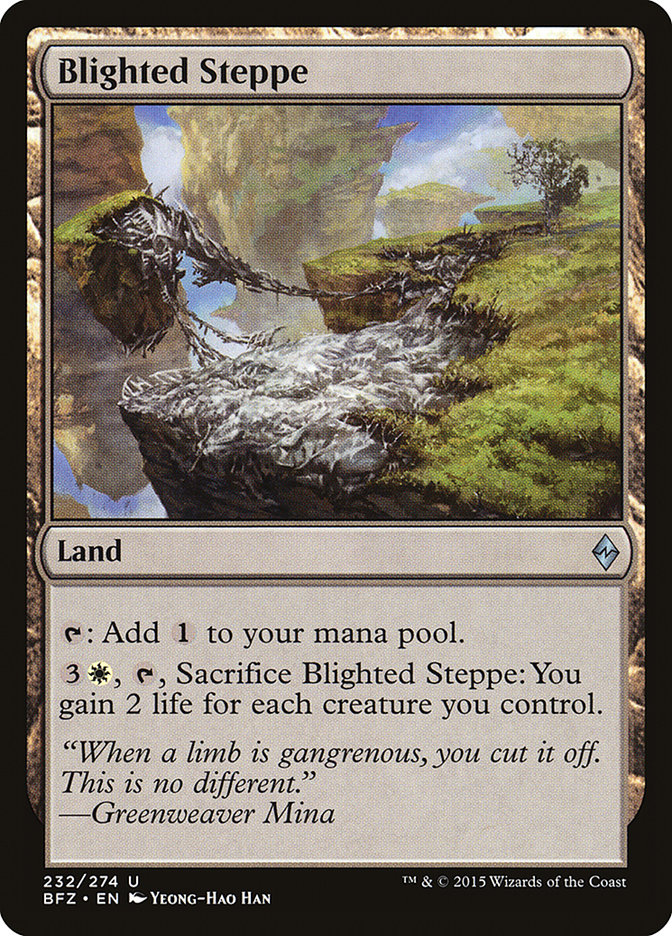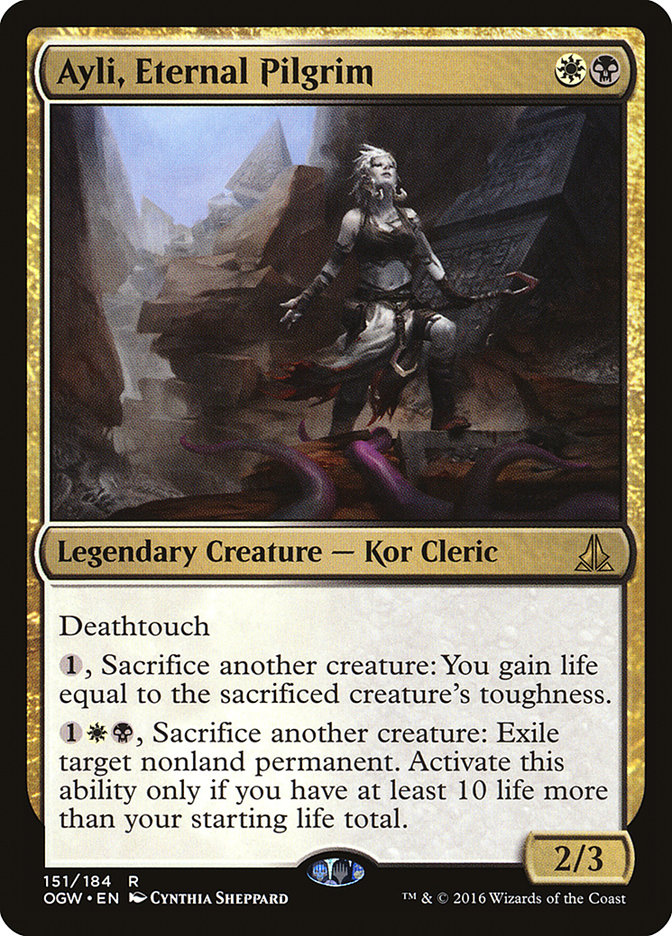We talk a lot about brewing as though it were a monolith, a singular pursuit among the many that Magic offers its devotees, but within this one sliver of the game there are several approaches.
Some brewers spit out ideas at a rapid-fire pace, often scribbling out list after list and not stopping to review or refine them until later in the process. It’s a stream-of-consciousness style that can lead to some unique ideas but they are usually rough and take time to tune.
Personally, I prefer to home in on a few cards or a shell I really like and explore it in depth. I don’t necessarily find my way better than the other, but I often find myself focused on a narrow set of cards, unable to get my mind off of them. With how important context is in card evaluation, our first idea for how to best utilize a new card is often wrong, so I want to look at several shells and compare them before moving forward.
Last week, the card on my mind was Bontu’s Last Reckoning, a powerful sweeper with a significant drawback that required some attention in deckbuliding to properly mitigate. Today I’m focused on another card that needs attention in deckbuilding, but to take advantage of its enormous upside rather than compensate for its downside. That card, which failed to garner much press in preview season, is Crested Sunmare.
Wingmate Roc and Broodmate Dragon are easy comparisons to draw some positive attention to Crested Sunmare, but it’s important to note how much easier it was to generate a second creature with the former two. Broodmate Dragon gave it to you every time, while Wingmate Roc required only that a creature have attacked, making it an ideal curve-topper.
With Crested Sunmare, you have to gain life, which is much more difficult, but in return you get the opportunity to make a token each turn for the rest of the game and the peace of mind knowing that, so long as the mother Horse remains, the others won’t be lost to a sweeper other than Hour of Devastation. Magic is very much about achieving immediate impact easily, so I think the prior analogs are better overall, but there’s a lot of room for Crested Sunmare to thrive.
There are a lot of cards in Standard that gain life, so wading through them can be daunting, but after some thought, here are the guidelines I came up with for what I was looking for to get the most out of our mythic Horse.
1. Minimize underpowered cards. We have this idea of synergy as a force that makes bad cards good because they become more than the sum of their parts. When the synergy is strong enough, that can be true, but the bar there is high. Unless you are doing something incredibly powerful, you end up with a glass cannon of a deck that can’t compete without its synergies coming together.
I want a deck that can stand on its own in a pound-for-pound fight, but with the capability to use its synergies to make good cards great. That means cards like Retreat to Hagra, Drana’s Emissary, and Implement of Improvement are not going to make the cut in anything but the smallest of numbers.
2. Make the first token immediately. Broodmate Dragon and Wingmate Roc drew their power from their high immediate effect on the battlefield. Traditional removal matched up poorly against either as a result of creating two sizable bodies at once. With Crested Sunmare, our opponent will always have the opportunity to hold up an instant-speed removal spell for it, but since the 5/5 body dodges Grasp of Darkness and most early Harnessed Lightnings, we should have the opportunity to get at least one trigger out of it. It’s imperative we take advantage of that window and create a sizable tempo swing.
That means one-shot lifegain cards like Blessed Alliance, while still valuable, aren’t our primary synergy pieces. We need permanents that can gain life without spending mana the turn we cast Sunmare, like creatures with lifelink and planeswalkers with abilities that gain life.
3. Don’t go overboard on synergies. Once the first Horse is made, Crested Sunmare has done its job. Any further value accrued should be viewed as a bonus, so we don’t have to go all-out including as many life gain effects as possible, especially because we know many of the main sources will be repeatable anyway, per the second guideline.
Okay, those three points provide a solid baseline framework from which to operate, and in comparing the list of potential synergy pieces from a quick Gatherer search, I have four primary candidates to build with. I’ll start with the creature and the Vehicle: Glory-Bound Initiate and Aethersphere Harvester.
These don’t need much explanation. Both are effectively lifelink creatures that are proven to be Constructed-playable. Moreover, they have bodies that will get into combat easily without sacrificing value on the turn you want to gain life, either due to sheer size or evasion. You’ll likely chump attack either of these creatures to get a 5/5 indestructible anyway, but you’d certainly rather not, so knowing that these creatures won’t often put you in those situations is some nice added peace of mind.
There are certainly other lifelink creatures that could fit on this list, but I don’t think any of them rise to the level of these two. For example, Gifted Aetherborn is rough on your mana in what is likely to be a base-white deck, and Gisela, the Broken Blade matches up very poorly against the removal in Standard. These should still be considerations if they fit a given deck, but they aren’t going to be cards I repeatedly look for and build with in mind.
Next are the two planeswalkers, Dovin Baan and Sorin, Grim Nemesis. The latter has a long history in Standard as a top-end planeswalker, while the former has yet to find a home, but its stats are certainly there on paper. The major issue Dovin Baan has had is that its low loyalty makes it difficult to protect if you want to use its -1 ability, but casting it on turn 4, using its +1, and then untapping to draw a card and make two 5/5s should make protecting it a lot easier.
Sorin, Grim Nemesis doesn’t need any justification by itself, as it’s just a great card, but it does play awkwardly as a six-drop enabler for a five-drop. It’s not going to be a part of our best curves, but it’s a repeatable source of lifegain attached to a powerful card, so I’m willing to make it work.
Step two is complete: we’ve identified some key support cards for Crested Sunmare. Now it’s time for everyone’s favorite part: decklists. The above planeswalkers identify two distinct paths we can go down, so for no particular reason, let’s start with B/W.
Creatures (16)
- 2 Ayli, Eternal Pilgrim
- 2 Kalitas, Traitor of Ghet
- 4 Thraben Inspector
- 4 Glory-Bound Initiate
- 4 Crested Sunmare
Planeswalkers (7)
Lands (26)
Spells (11)

There’s a lot to like here. I’ve fit nine copies of our core support cards along with nine other sources of lifegain, only three of which are on cards that are the least bit questionable. Ayli, Eternal Pilgrim hasn’t seen a lot of play in its lifetime in Standard, but it has seen some, and the raw stats are solid on a two-drop. It crews Aethersphere Harvester well and plays defense. Its lifegain ability is important because it’s the only one in the deck you can use at instant speed, letting you make a Horse on their end step for the low price of one mana and a spare 2/2 token or Thraben Inspector.
The Blighted Steppe, however, is much more marginal and something I’m including solely because I think the two-color mana here is solid, especially with the Evolving Wilds, mainly included to help out Fatal Push. If it turns out you want fewer enters-the-battlefield-tapped lands, the colorless utility land is an easy cut, but in an early draft, I’m always looking for added value in strange places.
The early creatures, in addition to supporting Aethersphere Harvester, help protect Gideon, Ally of Zendikar, which you wouldn’t think would need any mention here given its pedigree, but it serves an important purpose: it gets your Horse army out of Hour of Devastation range. Against any midrange red deck, you can confidently emblem your planeswalker and present an army of 6/6s that will be very difficult for them to answer, and since I expect Hour of Devastation to see significant play, that’s an important trick to have in your bag.
I’m tempted to work some copies of Blessed Alliance or Collective Brutality in the removal suite, since they’re both fine Standard playables, but they are a step down from the other options, especially when you consider that the lifegain in this deck allows you to play an abnormal number of copies of Anguished Unmaking, an underrated draw to black.
And now to blue:
Creatures (18)
Planeswalkers (7)
Lands (25)
Spells (10)

You don’t have as many sources of lifegain in the blue version of the deck, but twelve is still a healthy number, and the Giselas in the sideboard help you compensate should want to sideboard some of them out.
With Dovin Baan in the four-slot, I changed from Gideon, Ally of Zendikar to Gideon of the Trials. In addition to being better on the curve, the latter helps you protect Dovin, thus setting up the big swing on turn 5.
I’m more worried about the creature situation at the bottom of the curve. Selfless Spirit and Spell Queller aren’t ideal in a deck like this that wants to tap out with high-impact cards, but they’re the best options among a relatively weak group. They can also help protect your Sunmare so it survives to your end step to make a token, but as I mentioned earlier, I don’t want to build a deck that’s all-in on its synergies.
Overall, I prefer the black list, but of the four pieces, I think Dovin Baan is the best, so I’d be interested in further exploring that pairing. Perhaps a slower, more controlling Esper list could incorporate all the necessary pieces while making the mana work, but that would require a lot of time to get the manabase operating smoothly in a Standard format that is quite punishing of the lost tempo from lands entering the battlefield tapped.
I think I say this every time, but it doesn’t feel so long ago that we were looking to what Amonkhet would do for Standard, and here we are at the release of another set. I’ve been playing Magic for fifteen years and I’m still not used to how quick the turnaround is between sets.
It used to be that major tournaments were so sparse that you didn’t have them every release weekend, so getting an early jump and testing as much as possible in those first few weeks wasn’t as pressing a need. Then again, maybe I’m just getting more cantankerous in my old age. Last weekend was my first one away from the tables in six weeks, and while I’m excited to get out to #SCGCIN this weekend, I wouldn’t say no to some more time to look at what Hour of Devastation has to offer.
Okay, I’ll get off my high horse now.


